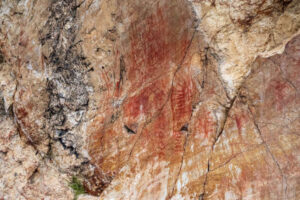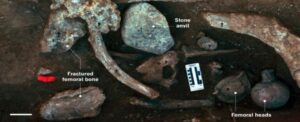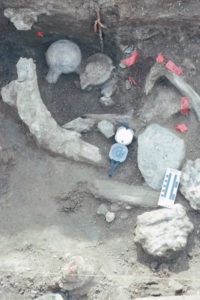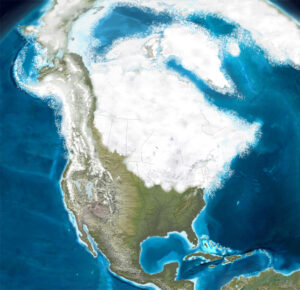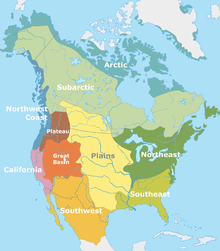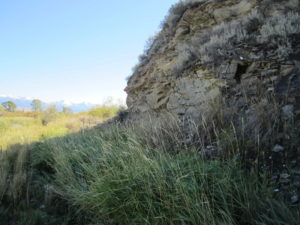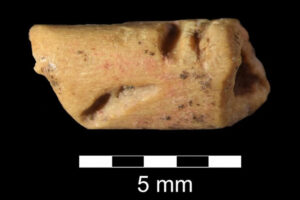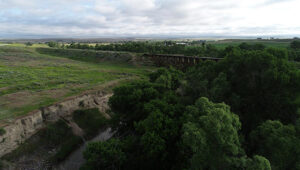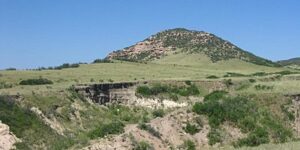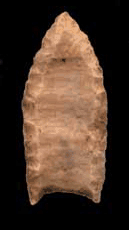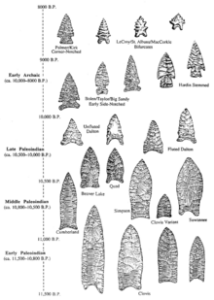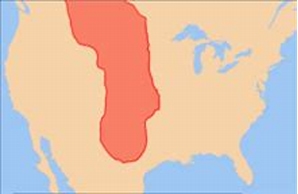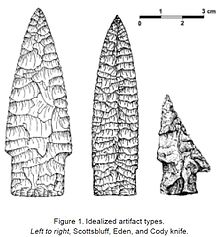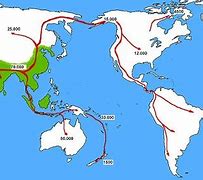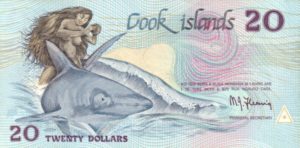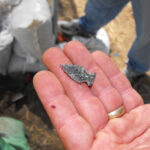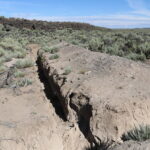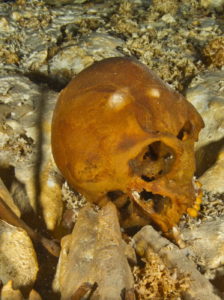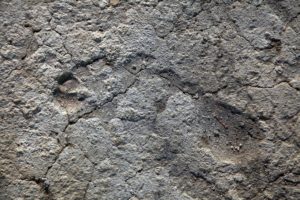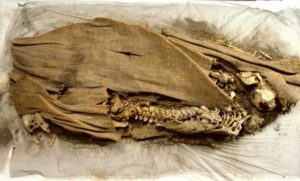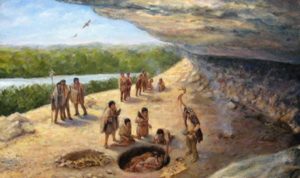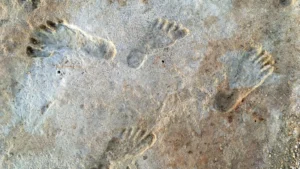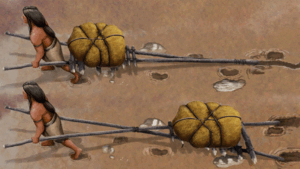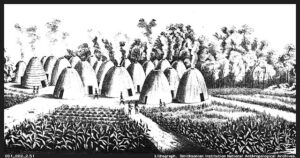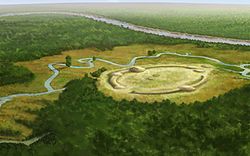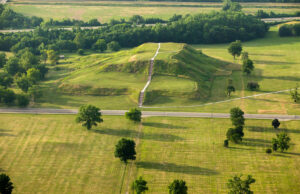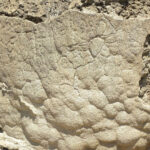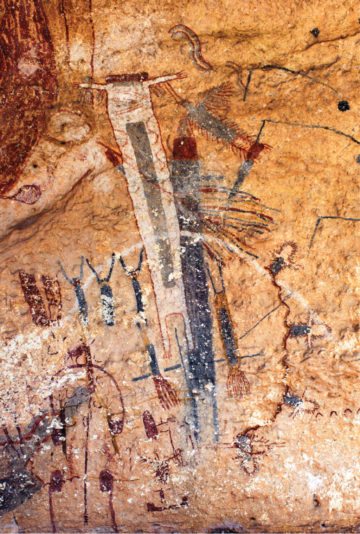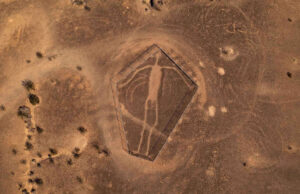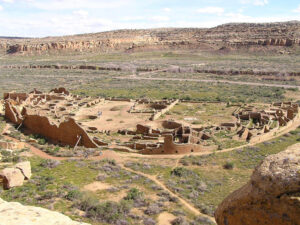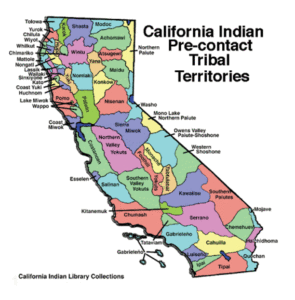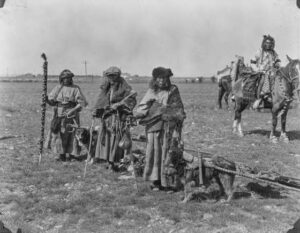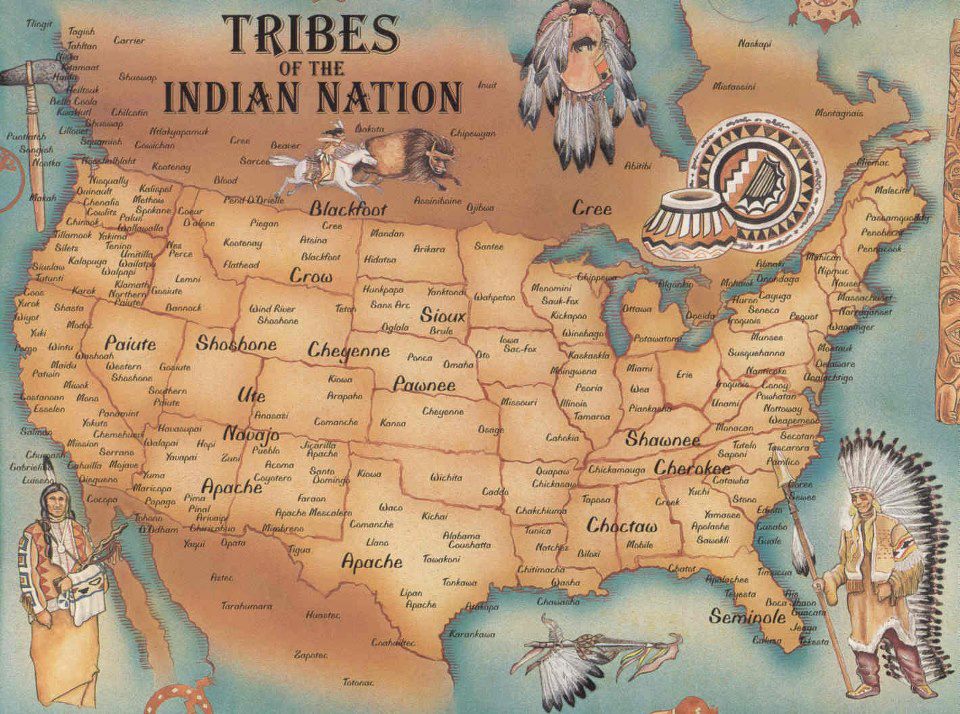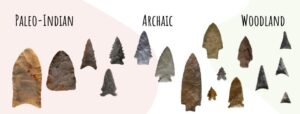Use Cmd/Ctrl+F to search Native American Pre-History
Working links are Red, other references, use Navigation Panel choices.
Names in bold will be found in Players or Dictionary
Bolded Titles in References – Books (two lists).
Native American Pre-History
There is NO PAYWALL on this page.

A very concise look at Native American Pre-History.
The indigenous peoples of North America.
Where they came from, how and when and who they might be now…
First People, those we call Native Americans. Here, we will begin to see where they came from, and who they might be…
This field of study is so active that our information and perspective could/should likely be updated daily! Best to just keep an open mind and watch it happen. It’s an amazing and wonderful part of the ever-unfolding story of the Old West, and ourselves. Old West Daily Reader aims to keep us informed and somewhat current. Just remember, this is a mighty small window…
Where to begin? First People
Who was first? Where did they come from?
A flash look at the current perspective…
The Cerutti Mastodon site
Before all of us? There is a current claim of the oldest evidence of human activity in North America — the broken bones of a mastodon dating back some 130,000 years at The Cerutti Mastodon site * (San Diego, CA). The heart of the claim is that mastodon femur bones found here, have been broken in a way only humans could accomplish. No predator of the time had strong enough jaws. Moreover, the bone appears to have been smashed by being placed on a small stone (think anvil), then a large, heavy stone was thrown down on the middle of the long thigh bone (acting like a hammer), shattering it and allowing access to the marrow. This process also provides pieces and splinters of bone to be used as is or made into tools. Then, it appears the bones may have been “arranged”. No identifiable “tools” (bone or stone) have been found at the site.
This photo, part of series taken at the site, shows mastodon bones that appear to have been “processed when fresh” and “arranged”. There is also a possible “anvil” and a “hammerstone” thought to have been used to break some of the bones, associated with the find. The 130,000-year-old fossil remains were discovered in November 1992 and excavated over the next 5 months by Museum paleontologists at a freeway expansion project site in San Diego, CA. Photo: U.S. PD? San Diego Natural History Museum, Fair Use.
This is a still very contentious discovery and theory. {001}
(This is the 2nd update to this article (02/04/2024) More maybe later…
based partly on an article in The San Diego Union-Tribune (2024)
* FYI: The name Mastodon itself is now extinct, today they are Mammuts.
see:
References – Dictionary – Mammut
References – Dictionary – Epoch – a time chart
An interesting recently verified discovery is Chiquihuite Cave in the mountains of Mexico. Ancient stone tools that date at least 31,000 years old. Other dating leads scientists to believe the site may be as much as 33,000 years old. As of the report, no human DNA has been discovered. There are other sites being studied around North America that appear to be approaching these dates.
(Article July 2020) – Updates as they occur. – Doc
see also:
One buried, beautiful, bountiful, bunny bone bead… – below (2024)
See also:
The Originals Index – Horses – Dr. Yevette Running Horse Collin
![]()
Pre-Columbian era
The Pre-Columbian era incorporates all period subdivisions in the history and prehistory of the Americas before the appearance of significant European influences on the American continents. Spanning the time of the original settlement in the Upper Paleolithic period, to European colonization during the Early Modern period.
True, the phrase “pre-Columbian era” literally refers only to the time preceding Christopher Columbus’s voyages of 1492. However, in practice, the phrase is usually used to denote the entire history of indigenous Americas cultures until those cultures were vanquished, diminished, or extensively altered by Europeans. Even if this happened decades or centuries before Columbus’s first landing. For this reason, alternative terms such as: Precontact Americas, Pre-Colonial Americas or Prehistoric Americas are also in use and will likely replace any reference to Columbus. In Latin America, the term usually used is Pre-Hispanic. The Norse colonization of North America is generally not treated as “pre-Columbian”, despite the fact that it predates Columbus by several centuries.
see also:
References – Dictionary – Indigenous
References – Dictionary – Indigenous Peoples’ Day
References – Dictionary – Epoch – a time chart
Recent research has indicated that people reached the American continent
at some time near the end of the last ice age
(which lasted between about 120,000 years ago t0 around 6,000 years ago).
Any potential movements likely occurred during or after the Last Glacial Maximum (LGM)
(when ice sheets and glaciers reached their greatest extent),
approximately 19,000 to 26,000 years ago.
Map of North American ice sheets c . 13 000 ybp
Map U.S. © Williams College? internet – Fair Use
Showing the alleged “migration corridor”.
This route is just one of the many suggested avenues by which ancestral peoples might have arrived in North America.
A number of these options will be addressed below…
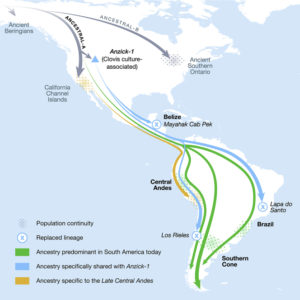
Reconstructing the Deep Population History of Central and South America. Map Credit: Michelle O’Reilly; Posth, Nakatsuka et al. 2018
Exactly when the first group of people migrated into the Americas is the subject of much debate. Asian nomads are thought to have entered the Americas via the Bering Land Bridge (Beringia), now the Bering Strait and likely along the coast as well. New DNA studies indicate that the first group was likely about 250 people. Later genetic evidence found in Amerindians’ maternally inherited mitochondrial DNA (mtDNA) supports the theory of multiple genetic populations migrating from northern Asia and perhaps a small contribution from as far south as Micronesia. * There is currently some claim of paleo-evidence/influence from Europe on America’s east coast.
Native Americans have been separated into two branches by geneticists: Northern and Southern. The Northern group came from East Asia and likely inhabited North America, including Alaska and Canada.
At some point, the group split, the Southern Native Americans migrating to South America. They all descended from the Ancient Beringians, but the separation created variations in their DNA.
Today, the chronology of migration models is divided into two general approaches. The Short Chronology Theory suggests that the first movement beyond Alaska into the New World occurred no earlier than 14,000–17,000 years ago, followed by successive waves of immigrants. Artifacts have been found in both North and South America which have been dated to 14,000 years ago, and it has been proposed that the migrants had reached Cape Horn at the southern tip of South America by this time.
The long chronology theory proposes that the first group of people entered the hemisphere at a much earlier date, possibly 50,000–40,000 years ago or earlier. Sites dating back to 20,000 years ago have been claimed.
New research (2023) indicates that conditions would have been most conducive to early migration along the Alaskan coast, 24,500-22,000 years ago, and 16,400-14,800 years ago, perhaps aided by the presence of winter sea ice.
According to a new DNA study of ancient and modern Indigenous people (2022), some of the first ice age people who ventured into the Americas hailed from northern China. Ice age groups in the ancient northern coast of China helped make up the first wave of people to settle the New World. The ancient groups may have also migrated to Japan, potentially helping explain similarities in Stone Age artifacts in the Americas, China and Japan. While these new findings suggest a single northern Chinese lineage may have contributed to Indigenous American ancestry, it does not represent the whole history of all Native Americans.
see:
*”Dusty” Crawford” article below.
Clovis Culture
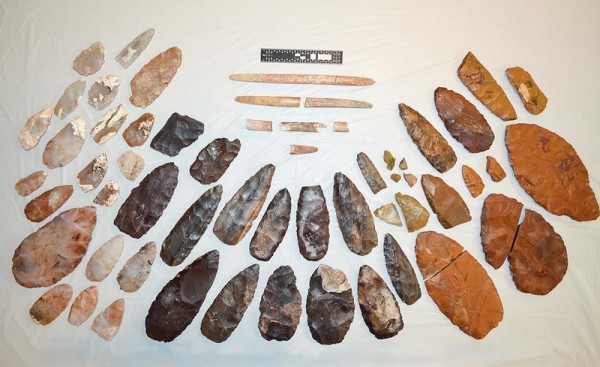 Latest DNA based genetic research now indicates that all Western Hemisphere Native Americans are descended from a single gene pool with roots in Asia [the Mal’ta boy, Siberia of about 24,000 years ago]. The Okunev people of Siberia are related to Native Americans, and it has been suggested that they were the group who populated the Americas. However, there is also a current contention than some “mixing” took place, in transit, with people bearing genes indicating a southeast Asian origin. This is thought to have taken place before these Siberian peoples descended into North America.
Latest DNA based genetic research now indicates that all Western Hemisphere Native Americans are descended from a single gene pool with roots in Asia [the Mal’ta boy, Siberia of about 24,000 years ago]. The Okunev people of Siberia are related to Native Americans, and it has been suggested that they were the group who populated the Americas. However, there is also a current contention than some “mixing” took place, in transit, with people bearing genes indicating a southeast Asian origin. This is thought to have taken place before these Siberian peoples descended into North America.
There is also a recent theory about traveling on sea ice rather than ice free land corridors. Some climate data indicates that favorable conditions for migration may have existed between 24,500-22,000 years ago and 16,400-14,800 years ago, coinciding with winter sea ice (2023).
The only Clovis Culture grave ever found, the Anzick boy [Montana – 1968], dates at about 12,500 years old. It is that of a one-year-old boy, complete with red ocher * on the body and a large selection of Clovis style bone and stone tools. The evidence set strengthens the perception that all Native Americans are descendants of the Clovis People. Canadian Native Americans appear not directly related to the baby, but to his family. Some 80% of all other Native Americans but mostly those now in Central and South America, prove to be directly related to the baby. (Maybe Not!)
see:
* References – Dictionary – Red Ochre, Ochre
References – Dictionary – Younger Dryas
References – Dictionary – Epoch – a time chart
Maybe not! see: Darrell ‘Dusty’ Crawford – below
The Originals Index – Trappers and Hunters – Trappers and Hunters – Pre-Historic Hunters
Photo Gallery Index – Weapons Photos – Native American Weapons
One buried, beautiful, bountiful, bunny bone bead…
Beads were/are used, by prehistoric Native Americans and modern ones, as personal ornaments, to decorate their bodies, clothing and other items. The production and use of personal ornaments, such as beads, are important indicators of increasing cultural complexity among prehistoric humans. This is the oldest known bead found in the Americas and among the oldest of all known American human ornaments.
OK, it’s really a hare bone, but this bead, dates to around 12,940 years ago (end of the Pleistocene epoch and the Ice age). Distinctive grooves on the outside surface of the artifact indicate that it was made by prehistoric human hands. Researchers suggest that it offers hints about hunting, hierarchy, personal decoration, and even migration patterns, through a comparison of similar beads from different places and times. Note that it’s about the same age as the burial mentioned in the above article. It was discovered among other artifacts during excavation and study at the La Prele Creek site in Wyoming, by a University of Wyoming team led by Dr. Todd Surovell.
This “Clovis Period” find is a campsite next to a Columbian Mammoth butcher site. It is undetermined whether the giant beast was killed or scavenged by prehistoric Native Americans. This study is very new (2024) and this information is from press articles, not the teams report. Very interesting and educational. History Riders™ will pick up this trail again later… Photo: © University of Wyoming? – Dr. Todd Surovell – Fair Use. {001}
Drop 45 Drive Lane
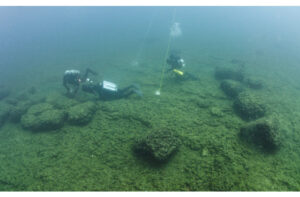
Archaeologist collecting samples
at Drop 45 Drive Lane in Lake Huron
Photo: U.S. PD ©? Dr. John O’Shea – Fair Use
120 feet below Lake Huron, an area the size of a football field with dozens of 9,000-year-old artifacts and human-built stone structures comprise the most complex prehistoric hunting structure ever found beneath the Great Lakes (2014). Great sheets of glacial ice extended far to the south; water levels of the Great Lakes were as much as 300 feet below today’s levels, when the construction of this 25 ‘ wide, 300’ long ambush area took place. Considerably more square miles of open land were exposed than we currently see. Those exposed shorelines were productive, full of wildlife and plants that attracted hungry humans. Early hunting communities likely targeted migrating caribou in particular, a species that’s adapted to cold climates and is (and was) “very predictable,” according to Dr. John O’Shea (an anthropology professor at the University of Michigan, Ann Arbor), who has led the research on underwater sites in Lake Huron. “It’s a Pompeii-type situation. Everything is totally preserved in cold, clear freshwater. You don’t get that often in archaeology.”
Similar hunting structures have been found throughout North America. Obsidian flakes discovered at the site originated in formations in Oregon, some 2,500 miles away. Information from the press, not the Team’s report. Photo: U.S. PD © U of M? Dr. John O’Shea – Fair Use. {001}
see also:
The Originals Index – Trade in the Old West – Minerals – Obsidian
Folsom tradition
The Folsom tradition is a Paleo-Indian archaeological culture that occupied much of central North America. Distinguished by fluted stone projectile points or spearheads (Folsom points), which are generally somewhat smaller than Clovis points *, to hunt smaller animals. The mega-fauna were mostly gone. Most known Folsom sites are Bison kill sites, often jumps, where bison were slaughtered and butchered. There are sites which contain the remains of up to 50 animals of all ages. In addition to bison remains, bones of cotton‐tail rabbit, deer, marmot and mountain sheep found at Folsom sites, illustrate the diversity of species exploited by these people (and likely others). The name comes from Folsom, NM the area where remains were first found (1922 **). The site received no scientific attention until 1926 – 27 and wasn’t accurately dated until about 1949. Later studies indicate that the tradition lasted from about 12,600 years ago to about 12,200 years ago. No campsite was found at Folsom. (Dr. Todd Surovell and team.
see also: Bunny Bead – above).
The Lindenmeier site (pictured) is a stratified archaeological site *** most famous for its Folsom component. It contains the most extensive, known at this time, Folsom culture campsite with calibrated radiocarbon dates (c. 12,300 B.P. (10,300 BCE)). This multi-component site has also produced artifacts from subsequent Archaic and Late pre-historic periods.
The site is on the former Lindenmeier Ranch, which is included in the Soapstone Prairie Natural Area, in northeastern Larimer County, CO, declared a National Landmark (01/20/1961). Photos: LH U.S. PD wikiwand; RH U.S. PD? internet. {001}
see:
* Clovis Culture – above
** Wk.35, 08/27/1922 – Johnson Mesa, NM
** Wk.35, 08/29/1927 – Folsom tradition
*** References – Dictionary –Stratigraphy
Photo Gallery Index – Weapons Photos – Native American Weapons
References – Dictionary – Bison antiquus
References – Dictionary – Epoch – a time chart
FYT: Predators? To a large kill site? Makes you wonder how they dealt with the wolves and “others” attracted to the ever-souring mammoths?
Dire Wolves? More modern ones? Both? Here Kitty, Kitty, BIG KITTY! – Doc
They find a nice variety of ’em from these times in the tar pits at La Brea (CA). *
see also:
* References – Dictionary – La Brea Tar Pits
References – Dictionary – Bison antiquus, Columbian Mammoth,
Dire Wolf, Saber Tooth Tiger, Wolfers
References – Dictionary –Epoch – a time chart
Plano Cultures
The last group of prehistoric Native American people or Paleoindians, the Plano cultures existed in North America during the Paleo-Indian or Archaic period between 9000 BCE and 6000 BCE. They originated in the plains, but then extended from the Atlantic coast to modern-day British Columbia and as far north as the Northwest Territories. Characterized by a range of unfluted projectile point tools collectively called Plano points *. As with the Folsom tradition people, they hunted Bison antiquus, making even greater use of techniques to force stampedes off of a cliff or into a constructed corral. Studies indicate that their diet also included: coyote, deer, elk, pronghorn and raccoon. They preserved meat in berries and animal fat and stored it in containers made of hides. Is this the true genesis of pemmican? ** {001}
see also:
* Archaic and Late pre-historic Projectile Points – above article
** The Originals Index – Commerce in the Old West – The Pemmican Trade
References – Dictionary – Bison antiquus
References – Dictionary – Epoch – a time chart
Cody complex
A Paleo-Indian culture group first identified near Cody, WY (1951) at a Bison antiquus kill site. Primarily in the High Plains portion of the American Great Plains, most Cody complex sites are bison kill and butcher sites, some with campsites. Cody sites are distinguished by their campsites, tools and butchering process. Tools date between about 8,000 to 6,000 BC. Points characteristic of Cody Complex flaking have been found all across North America from Canada to as far south as OK and TX. Photo: U.S. PD? internet. {001}
see also:
Photo Gallery Index – Weapons Photos – Native American Weapons
FYI: Evidence at the Heisler Paleo-Indian butchering site (southern MI) includes successfully storing meat underwater. – Dwight C. Fisher (1980) The process was verified by considerable modern experimentation. – Doc
![]()
Other recent discoveries as food for thought…
Darrell ‘Dusty’ Crawford – Montana Blackfeet
Oldest DNA in America
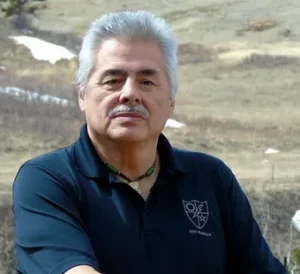 Darrell ‘Dusty’ Crawford, a member of the Montana Blackfeet tribe, had always been told his ancestors came from Siberia, across a land bridge. But his tribe told a different story, “We’ve always been here, since time immemorial,” said Shelly Eli, an instructor at Blackfeet Community College. “There’s no oral stories that say we crossed a bridge or anything else.” So Dusty sought his own answers. At the urging of his late brother Willy, he took a CRI Genetics, DNA Ancestry Test* and discovered that he could trace his ancestry back 17,000 years! True, he was 83% Native American, but more surprising, he found that his North American ancestry was older than the land bridge that once connected Alaska to Siberia, where he had been told his ancestors had come from, in school. Instead, Crawford’s results suggested that his ancestors came not by bridge, but by boat. Current theory suggests his closest genetic ancestors, some of the first people to set foot in the Americas, had arrived in South America from the Pacific Islands, not Siberia. Remains found in Peru contain DNA from the same haplogroup** as Dusty Crawford, meaning that he can trace his lineage directly back down to Peru, and back across the Pacific Ocean for 55 generations. His ancestors would have then worked their way as far North as Alaska, over many generations of travel. 83% of Crawford’s DNA matches up with Native Americans. The rest of it showed his diverse heritage; about 10% European, about 5% East Asian, 2% South Asian and less than 1% African. Photo: U.S © Great Falls Tribune, Dusty Crawford (2019 – crop) Fair Use. {001 – 2000)
Darrell ‘Dusty’ Crawford, a member of the Montana Blackfeet tribe, had always been told his ancestors came from Siberia, across a land bridge. But his tribe told a different story, “We’ve always been here, since time immemorial,” said Shelly Eli, an instructor at Blackfeet Community College. “There’s no oral stories that say we crossed a bridge or anything else.” So Dusty sought his own answers. At the urging of his late brother Willy, he took a CRI Genetics, DNA Ancestry Test* and discovered that he could trace his ancestry back 17,000 years! True, he was 83% Native American, but more surprising, he found that his North American ancestry was older than the land bridge that once connected Alaska to Siberia, where he had been told his ancestors had come from, in school. Instead, Crawford’s results suggested that his ancestors came not by bridge, but by boat. Current theory suggests his closest genetic ancestors, some of the first people to set foot in the Americas, had arrived in South America from the Pacific Islands, not Siberia. Remains found in Peru contain DNA from the same haplogroup** as Dusty Crawford, meaning that he can trace his lineage directly back down to Peru, and back across the Pacific Ocean for 55 generations. His ancestors would have then worked their way as far North as Alaska, over many generations of travel. 83% of Crawford’s DNA matches up with Native Americans. The rest of it showed his diverse heritage; about 10% European, about 5% East Asian, 2% South Asian and less than 1% African. Photo: U.S © Great Falls Tribune, Dusty Crawford (2019 – crop) Fair Use. {001 – 2000)
* Which aims to provide customers with a “biogeographical ancestry,” a description of where their genes fit into the overall story of the species.
* *MtDNA Haplogroup B2, which originated in Arizona about 17,000 years ago and yet today, maintain a low frequency in Alaska and Canada.
see also:
The Originals Index – Native American Tribes – Blackfeet
Is this how it happened?
MtDNA Haplogroup, one of four major Native American groups that spread across the continent. Called clans, they trace back to four (modern named) female ancestors, Ai, Ina, Chie and Sachi. Crawford’s DNA says he’s a descendant of Ina. Ina’s name comes from a Polynesian mythological figure, a representative of the “first woman.” She rides a shark on a Cook Islands $20 bill.
According to the DNA testing company CRI Genetics, “Its path from the Americas is somewhat of a mystery as there are no frequencies of the haplogroup in either Alaska or Canada. Today this Native American line is found only in the Americas, with a strong frequency peak on the eastern coast of North America.” To date, the company has never been able to trace anyone’s DNA ancestry in the Americas, back as far as Crawford’s. The DNA group’s closest relatives outside the Americas are in Southeast Asia.
References: Internet, Great Falls Tribune (MT) (05/06/2019), Live Science and several other publications.
The Japanese Connection
Cooper’s Ferry archaeological site (ID: Radiocarbon dating indicates that people lived in the Columbia River Basin around 16,000 years ago. Some 1,500 years, or more, before a corridor opened between the ice sheets. Before an inland route south from the Bering land bridge existed. Suggesting that people migrated south along the Pacific coast. Stone tools from the site suggest a possible connection between these first Americans and Northeast Asian hunter-gatherers from the same period. Local Nez Perce (Nimiipuu) know the site as the location of an ancient village called Nipéhe. Discarded stone tools discovered there don’t look like the fluted projectile points associated with the Clovis culture, they’re clearly a distinctly different technology. Did the ancient people who lived in Idaho 16,000 years ago have links to Japan (The Jomon)? That’s the tantalizing implication of a collection of 14 stone projectiles discovered by archaeologists at Cooper’s Ferry in 2022. It’s unclear whether the points were thrown away or cached for later use, but they resemble similarly shaped stone projectiles carved even longer ago across the Pacific, they shaped the base of the point into a stem to attach to the spear or arrow shaft, strikingly similar to stemmed points from Northeast Asia. Similarities are especially strong with items from the Japanese island of Hokkaido.
As with all such discoveries, the results are not all in, there’s certainly more to this story… Photo: U.S. PD – BLM. {001}
FYI: “The Jomon people who lived in Japan 15,000 years ago are an unlikely source for Indigenous Americans. Neither the skeletal biology nor the genetics indicate a connection. Only 7% of dental samples showed any overlap with non-Arctic Indigenous groups in the Americas. – Doc
The Chinese Connection
In 1989 a cranium was discovered in Red Deer Cave in the Yunnan province of China. Recent DNA analysis has now confirmed that the 14,000-year-old skull is from a member of our species, Homo sapiens. This is the first time an East Asian genome has been sequenced from the time when people were migrating into North America. The studies of this female individual, now known as Mengzi Ren, has verified genetic ties of Native Americans to East Asian ancestors. Previously, such ancestry has only been inferred by analyzing the DNA of living people. Researchers speculate that these people may have traveled north along the coastline of present-day eastern China and through the Japanese islands, before crossing into America from Siberia. *
There is a growing body of evidence that Chinese explorers landed on the Pacific coast of the Americas long before Columbus (1492). A garment from the Nez Perce tribe of present-day Idaho that dates at over 300 years old has ornaments woven into it that are believed to be Chinese beads.
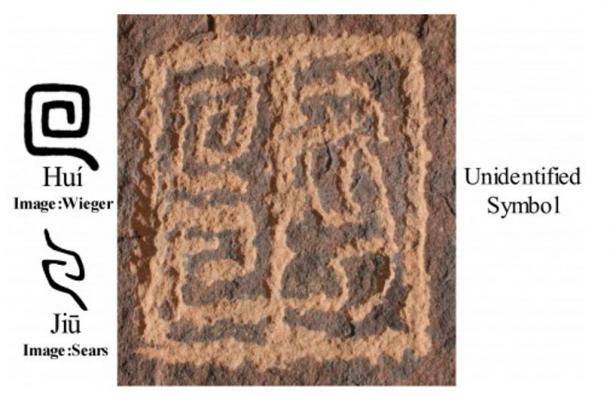
Petroglyph National Monument
Cartouche 3, (3 of 3)
Photo: U.S. PD? internet
In Albuquerque’s Petroglyph National Monument, experts on Native American rock writing and ancient Chinese scripts conclude that a readable message among these petroglyphs were likely inscribed by a group of Chinese explorers thousands of years ago (c. 1046 B.C.E.). There are other clues elsewhere: Arizona, California, Oklahoma, Nevada, Utah, Ontario, Canada and South America.
This issue will, no doubt, sort out with time… {001}
* Reference: Current Biology, DOI: 10.1016
Rimrock Draw Rock Shelter, OR
Apparently dating back about 18,250 years (Radiocarbon dating), tooth enamel from fragments of camel teeth and a cache of stone tools (possibly older), marked with bison blood, set the stage for a debate as to whether this site is the oldest evidence of human occupation in western North America. Photo: U.S. PD BLM (2016) prior to excavation for study. Excavated by the University of Oregon. {001}
Mexico
The recent find of a complete female skeleton (teenager) in a water-filled Yucatan cave has yielded radiocarbon dates between 12 and 13,000 years ago, backed up by mitochondrial DNA from a wisdom tooth. That sample, also confirms the Siberian ancestry, noted above, on the mother’s side. Studies of nuclear DNA to determine the paternal ancestry, have not yet been completed. Much more will come from this well-preserved, complete find.
Photo: U.S. PD? Hoyo-Negro Skull. {001}
Mexico and Southwest Texas
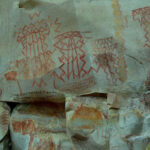 Pecos River Style ancient rock art and petroglyphs. Archaeologist Carolyn Boyd co-authored a study suggesting that the style’s dots and lines of red pigment are supposed to represent sound (2021). The study suggests these 2,000-year-old speech bubbles “denote speech, breath and the soul.” Some figures have delicate lines from their mouths as though whispering, while one has energetic zigzags as though shouting. Photos: LH Pecos River Rock Art © panza rayada, Fair Use. RH Dr. Carolyn Boyd U.S. PD SHUMLA. {001}
Pecos River Style ancient rock art and petroglyphs. Archaeologist Carolyn Boyd co-authored a study suggesting that the style’s dots and lines of red pigment are supposed to represent sound (2021). The study suggests these 2,000-year-old speech bubbles “denote speech, breath and the soul.” Some figures have delicate lines from their mouths as though whispering, while one has energetic zigzags as though shouting. Photos: LH Pecos River Rock Art © panza rayada, Fair Use. RH Dr. Carolyn Boyd U.S. PD SHUMLA. {001}
see also:
White Shaman – below
Canada
Twenty-nine shoeless footprints were left by two adults and a child at the water’s edge on Calvert Island, British Columbia. They are 13,000 years old. Photo: U.S. PD? Calvert Island, BC 13,000-year-old footprint. {001}
Nevada
A new genetic analysis of the 10,600-year-old Spirit Cave (NV) mummy* confirms that the individual’s DNA matches that of people from as far north as Alaska to as far south as Patagonia, indicating how fast that the continents’ first settlers had spread. The oldest North American mummy on record, was laid to rest in moccasins and a rabbit-skin shroud.
* Discovered in 1940
Siberia
In a new study, DNA analysis of bones from 10,000-year-old remains of an individual found at the Kolyma River in Siberia showed that the individual had traces of Ancient North Siberian ancestry. However, the majority of the DNA was attributed to another group, a “missing” genetic link to many Native Americans living today. The team dubbed them, Ancient Paleo-Siberians. “The 10,000-year-old individual at Kolyma River, is the closest old world relative of ancestral Native Americans among ancient humans studied so far.” – Martin Sikora, Lundbeck Foundation Centre for GeoGenetics (2019). Photo: Martin Sikora ©? U. of Copenhagen – Fair Use.
Alaska
And, just to add a bit of mystery to it all, the Upward Sun River Archaeological Site in the interior of Alaska has yielded an infant’s grave thought to be 11,500 years old. However, genetic analysis of a baby’s remains indicate that the baby belonged to a group of people who were genetically distinct from humans in northeastern Asia, the region that launched the migration into North America over the now-submerged land bridge across the Bering Strait (noted above). The data also showed that this group differed genetically from the two known branches of ancestral Native Americans. Does this indicate that a previously unknown human population was among the first to settle in the Americas? Who were they? Where are they?
Columbia River
One other interesting tidbit: Kennewick Man (8,500 years) has been definitely identified as ancestral to modern Native Americans by DNA from his hand. Possibly related to the Colville people, who were some of the first to claim him as one of their own. However, not all the tribes that claim Kennewick Man as an ancestor and very few others who might be related have yet to submit DNA samples, so there is still some doubt as to his actual living relatives.
The skeleton was discovered on the banks of the Columbia River by a couple in 1996. An arrow tip lodged in the man’s pelvis led the local coroner analyzing the remains to surmise that he was a European killed by Native Americans. However, the bones revealed him to be at least 8,000 years old and the controversy began… – Doc (2020)
New Mexico
Scores of human footprints that appear to be teenagers and younger children travelling back and forth, with the occasional track of an adult, were left in soft mud on the margins around the shore of the ancient (now evaporated) Lake Otero. A shallow lake, which today, is part of Alkali Flat at White Sands, NM. A U.S. Geological Survey team (2021) generated radiocarbon dates between 21,000 and 23,000 years old from seeds taken from sediment layers above and below the prints, meaning they were here before the park’s signature gypsum dunes.
Further examination of the trackway uncovered parallel drag marks preserved in these Pleistocene mudflats. Clearly in association with the footprints noted above. These traces, indicating the use of a travois, are now believed to be the oldest physical evidence of human vehicle use anywhere in the world.
This is some 7,000 years earlier than previously thoughts as to when the continent was first settled from Asia. Other prints show the people crossed paths with mammoths * and giant sloths. * The dust from this discovery has yet to settle (2025). {001}
See also:
* References – Dictionary – Columbian Mammoth
* References – Dictionary – Eremotherium (a giant ground sloth)
References – Dictionary – La Brea Tar Pits
References – Dictionary –Epoch– a time chart
Photo Gallery Index – Transportation Photos – 1st. Photo
New Mexico
Gomolak Overlook archaeological site. An 8,200-year-old campsite was unearthed at Holloman Air Force Base in New Mexico (2023). The prehistoric site had spent millennia buried beneath white sand dunes and may have been used by some of New Mexico’s earliest settlers. The site yielded a series of hearths, complete with charcoal remnants (announced 03/2024). {001}
“I can’t comment on how reliable the dating is (it is outside my expertise), but firm evidence of humans in North America 23,000 years ago is at odds with the genetics, which clearly shows a split of Native Americans from Asians approximately 15-16,000 years ago. This would suggest that the initial colonists of the Americas were replaced when the ice corridor formed, and another wave of colonists came in. We have no idea how that happened.” Photo: © U of C? – Fair Use
Dr Andrea Manica
Geneticist, University of Cambridge
see also:
Darrell ‘Dusty’ Crawford – above
Kansas
Estimated to have flourished from 1450 to 1700, the Native American city of Etzanoa * may have had a population of 20,000. Led by Dr. Donald Blakeslee, an anthropology and archeology professor; a Wichita State University archeology team excavated (2014+) the remains of what they believe is an indigenous merchant empire. Near Arkansas City, KS, a five-mile-long site between the Walnut and Arkansas rivers, shows signs of distinctive “thatched, beehive-shaped houses,” mirroring descriptions found in historical records. Thought to be part of Quivira.
Translated four-hundred-year-old Spanish documents provide a vivid picture of encounters with Spanish conquistadors. Francisco Vazquez de Coronado y Lugan * stumbled upon a Native American community of the Wichita people, (calling it “The Great Settlement“) during his fruitless search for gold (1541). A subsequent encounter with Juan de Oñate *** (1601), resulted in a battle which may have contributed to the abandonment of the city. As always with such things, there is controversary as to the interpretation of the find. Time will tell… Illustration: U.S. PD wiki, A Wichita village. {001)
see also:
* So called by a captive taken by the Spanish.
The Originals Index – Quotes Index – Commentators Quotes – Dr. Donald Blakeslee
** Wk. 38, 09/22/ 1554 –Francisco Vázquez de Coronado y Luján
*** The Originals Index – Expeditions – Spanish Expeditions from Mexico –
Juan de Oñate y Salazar
Photo Gallery Index – Weapons Photos – Firearms Oddities – Oldest Guns Found in America
References – Dictionary – Quivira
Archaic period
As the ice receded, the North American climate was unstable until about 10,000 years ago. This led to widespread migration among the Paleo-Indians, dictated by the changing climate and as preferred resources were depleted and new supplies were sought. Spreading throughout the Americas, they diversified into many hundreds of culturally distinct tribes moving from place to place. Hunter-gatherers, likely characterized by small, mobile bands consisting of approximately 20 to 50 members of an extended family. These small bands were thought to have subsisted primarily through hunting now-extinct giant land animals such as mastodon and ancient bison. Over time we have found a variety of the tools they made and used. Including unique styles of projectile points and knives, as well as less distinctive implements used for butchering and hide processing. In general, Arctic, Subarctic, and coastal peoples continued to live as hunters and gatherers.
Over the course of thousands of years, the vastness of the American continents, the variety of their climates, ecology, vegetation, fauna, and landforms, led ancient peoples to coalesce into many distinct linguistic and cultural groups. Agriculture was adopted in more temperate and sheltered regions. There, they domesticated, bred and cultivated a number of plant species. * (The majority of this agricultural revolution took place in South America.) These species were very nutritious, and they now constitute 50–60% of all crops in cultivation worldwide. Wherever it was adopted, plant cultivation permitted a dramatic rise in population.
The oral histories of these indigenous peoples describe a wide range of traditional creation stories. Often saying that a given people have been living in a certain territory since the creation of the world.
see:
*The Originals Index – Resources and Hazards – Plants – Food Plants
References – Dictionary – Epoch – a time chart

Europe
It turns out that research appears to strongly indicate that there was also immigration from Europe. Some of the archeological work referenced here goes back as far as the 1850’s in the American East and South. Adena mounds in North America (Kentucky, Georgia, Ohio, West Virginia, etc.) are similar to burial mounds in Europe, with concentric circles phallic symbols and standing stones. These enclosures are circular earth embankments with interior and/or exterior ditches. They include openings which appear to reference solar, lunar, and other astrological events. Occasionally, timber circles are incorporated in the designs as they are in Europe. American Mound Builder work often closely resembles European Neolithic and Bronze Age henges of around 3,000 to 2,000 BCE. There are also some common features between European and North American burials, in and around the mounds.
Structures of this nature do not occur in the American West, but the astronomical components do, such as at Hovenweep, White Shaman* and others. Photo: U.S. PD Kentucky Heritage Council. & Patrick G {001}
see below:
*White Shaman
 Left: Mt Horeb Earthworks in Kentucky, USA ( Kentucky Heritage Council ).
Left: Mt Horeb Earthworks in Kentucky, USA ( Kentucky Heritage Council ).
Right: Goseck Circle, Germany ( Patrick G / Flickr )

Eastern U.S.
The next four sections refer primarily to Paleo-Indian activities in the Eastern U.S.
Western Indians were still somewhat nomadic hunter-gatherers, without the horse.
There was eventually, widespread cultivation of South American developed crops.
The information is included here to help the continuity of the entire tale
and to help demonstrate the variety of Indian life before the white man came…
Middle Archaic period
Late Archaic period
Woodland period
Mississippian culture
Middle Archaic period
After the migration or migrations, it was several thousand years before the first complex societies arose, the earliest emerging about seven to eight thousand years ago As early as 6500 BCE, people in the Lower Mississippi Valley at the Monte Sano site were building complex earthwork mounds, probably for religious purposes. This is the earliest dated of numerous mound complexes found in present-day Louisiana, Mississippi and Florida. Since the late twentieth century, archeologists have explored and dated these sites. They have found that they were built by hunter-gatherer societies, whose people occupied the sites on a seasonal basis, and who had not yet developed ceramics. Watson Brake, a large complex of eleven platform mounds, was constructed beginning in 3400 BCE and added to over 500 years. This has changed earlier assumptions that complex construction arose only after societies had adopted agriculture, become sedentary, often developed stratified hierarchy, and generally also developed ceramics. These ancient people had organized to build complex mound projects from a different basis.
Late Archaic period
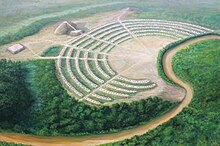
Poverty Point
Poverty Point, built about 1500 BCE, is the centerpiece of a culture extending over 100 sites on both sides of the Mississippi in the Lower Mississippi Valley. The entire complex is nearly a mile across with earthworks in the form of six concentric half-circles, divided by radial aisles, together with some mounds. Mound building was continued by succeeding cultures, adding effigy mounds, conical and ridge mounds and other shapes, built numerous sites in the middle Mississippi and Ohio River valleys as well. Photo: U.S. PD 2016 – Herb Roe
Woodland period
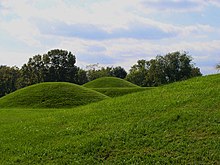
Hopewell mounds
Mound City Group in Ohio
The Woodland period of North American pre-Columbian cultures refers to the time period from roughly 1000 BCE to 1000 CE in the eastern part of North America. The term “Woodland” was coined in the 1930s and refers to prehistoric sites between the Archaic period and the Mississippian cultures. The Adena culture and the ensuing Hopewell* tradition during this period built monumental earthwork architecture and established continent-spanning trade and exchange networks. This period is considered a developmental stage without any massive changes in a short period, but instead having a continuous development in stone and bone tools, leather working, textile manufacture, tool production, cultivation, and shelter construction. Some Woodland peoples continued to use spears and atlatls until the end of the period, when they were replaced by the bow and arrows. Photo: U.S. PD 2016 – Herb Roe – Wikipedia article
see also:
*The Originals Index – Native American Tribes –
Native American Pre-History – Destroyed by a Comet
The Mississippian Culture
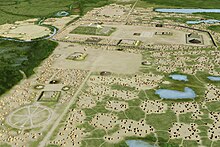
Cahokia
Largest Mississippian culture site
The Mississippian culture was spread across the Southeast and Midwest from the Atlantic coast to the edge of the plains, from the Gulf of Mexico to the Upper Midwest, although most intensively in the area along the Mississippi and Ohio Rivers. One of the distinguishing features of this culture was the construction of complexes of large earthen mounds and grand plazas, continuing the mound building traditions of earlier cultures. They grew maize and other crops intensively, participated in an extensive trade network, and had a complex stratified society. The Mississippians first appeared around 1000 CE, following and developing out of the less agriculturally intensive and less centralized Woodland period.
The largest urban site of this people, Cahokia, served as the center of a larger (theorized) sphere of influence known as the Ramey State, * which, in the majority opinion, appears to be chiefdom or a proto-state, due to the fact that certain indicators of a state, are not apparent in Cahokia’s ruins. Even so, the city may have reached a population of over 20,000 making it, at its peak between the 12th and 13th centuries C.E., the most populous city in North America. Its trade networks reached to the Great Lakes and Gulf of Mexico. Based on the varying strontium levels in human dental fragments found at the site, it appears that roughly a third of the population came from other areas in middle America. Monk’s Mound, the major ceremonial center of Cahokia, remains the largest earthen construction of the prehistoric New World. (Larger cities did exist in Mesoamerica and South America.) Other chiefdoms were constructed throughout the Southeast. In most places, the culture seems to have been in decline before the arrival of Europeans. Current studies suggest that this was at least partly due to climate changes and flooding on the Mississippi River.
Many Mississippian peoples were encountered by the expedition of Hernando de Soto in the 1540s, mostly with disastrous results for both sides. Unlike the Spanish expeditions in Mesoamerica, who conquered vast empires with relatively few men, the de Soto expedition wandered the American Southeast for four years, becoming more bedraggled, losing more men and equipment, and eventually arriving in Mexico as a fraction of its original size. The local people fared much worse though, as the fatalities of diseases* introduced by the expedition devastated the populations and produced much social disruption. By the time Europeans returned a hundred years later, nearly all of the Mississippian groups had vanished, and vast swaths of their territory were virtually uninhabited. Photo: U.S. PD 2013 Heironymous Rowe.
see also:
* Ramey State – The term was coined to refer to a larger theoretical state controlled by Cahokia, as the capital city, whose influence was felt in every location where ancient Ramey pottery has been found. – Conrad and Harn (1972)
References – Dictionary – Cahokia
Resources and Hazards – Plants – Functional Plants –Cassina
The Originals Index – Resources and Hazards – Disease

The Southwest – Greater Four Corners Area
8,000 – 6,000 BCE – 0ne A.D. (= or -) Rock Art (4)
6500 – 1500 B.C. – Archaic
1500 B.C. to 50 A.D. – Basketmaker (early)
50 to 500 A.D. – Basketmaker II (late)
500 to 750 A.D. – Basketmaker III
750 to 900 A.D – Pueblo I
900 to 1150 A.D. – Pueblo II
1150 – 1350 A.D. – Pueblo III
1350 to 1600 A.D. – Pueblo IV
Winnemucca Lake petroglyphs
Found in the Great Basin region (NV), these ancient rock carvings (petroglyphs) are some of the oldest examples of rock art on the continent. They are often cited as the first rock art in North America, believed to be more than 10,000 years old. Created by pecking and scratching the rock surface with stone tools, a variety of animals, human figures and symbols are depicted. The have been extensively studied by archeologists. Known as spirit circles, the concentric circles are thought to represent shamans. * {001}
Also Appears in Just for Fun Pages – Firsts in the Old West – 8, 000 BCE – Winnemucca Lake petroglyphs
see:
* White Shaman article – below: re: shaman ** and for petroglyph ** and pictograph **)
Horseshoe Canyon pictographs
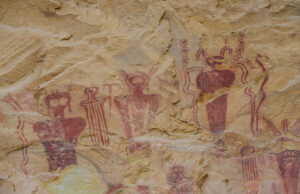
Horseshoe Canyon pictographs
U.S. © Bruce Montagne
Fair Use
Found in Canyonlands National Park in the remote desert landscape of eastern Utah, these rock paintings (pictographs), date back about 8,000 years. Painted in black and white and shades of red, are large, abstract human and animal figures. The art suggests the people who created it had a complex culture and belief system.
White Shaman*
Certainly, one of the most interesting examples is the, so called, White Shaman Rock Shelter in Texas, near the junction of the Pecos and Rio Grande Rivers. Discovered by the modern world in 1957. An unknown group, but possibly ancestral or related to the Huichol people of Norther Mexico, lived in this arid area 5,000 years ago. Other evidence indicates perhaps as much as 6,000 years before that. Research in the area has revealed much about this ancient culture: food, clothing, artifacts, astronomical knowledge, religious beliefs and technology. Here, they created some of the finest rock art in the southwest. In the shelter is a spectacular pictograph, a mural 26 feet long and 13 feet tall, thought to be around 2,000 years old. {001}
The White Shaman mural is painted on the east wall of a southwest facing shelter and faces due west. The positioning of figures within the mural suggests alignment with sun and shadow as observed on the solstices. Commentary and Photo: Chester Leeds.
* It should be noted that Native Americans, in general, reject and object to the use of the terms “Shaman” ** “Shamanism” ** in regard to their religious and spiritual practices. – Doc
see also:
** References – Dictionary – Shaman, Shamanism, petroglyph and pictograph
Books – Novels and History (non-ref) – Boyd, Carolyn
Similar to the famous Nazca lines of Peru and created in the same fashion, by removing the darker topsoil and gravel to reveal lighter earth beneath. Archeologists credit them to ancestors of existing local tribes of perhaps 450 to 2,000 years ago. A human, bird and a snake are depicted, with the largest figure measuring over 170 feet (52m) in length. There are a total of six distinct figures in three locations, with a human figure at each location and an animal figure at two locations. According to Mohave and Quechan tribes, the human figures represent Mastamho, the Creator of all life. The animal figures represent Hatakulya, one of two mountain lions/persons who helped in the Creation. In ancient times, sacred ceremonial dances were held in the area to honor the creation. {001)
6500 – 1500 B.C. – Archaic
Subsistence based on wild foods: high mobility with a low population density. Shelters and open sites; atlatl and dart; no pottery.
1500 B.C. to 50 A.D. – Basketmaker (early)
Long term seasonal use of caves for camping, storage, burial. Camp and limited sites in the open. Atlatl and dart; no pottery. Corn and squash but no beans; cultivation primarily on floodplain or runoff based (?).
50 to 500 A.D. – Basketmaker II (late)
Shallow pithouses plus storage pits or cists. Settlements dispersed with small low-density villages in some areas. Campsites are still important. Atlatl and dart; no pottery. Corn and squarsh but no beans. Some upland dry farming in addition to the floodplain.
see also:
References – Dictionary – Tattoo
500 to 750 A.D. – Basketmaker III
Now, deep pithouses plus surface storage pits, cists or rooms. Dispersed settlement with occasional small villages and great kivas. Atlatl sometimes replaced by bow and arrow, plain gray pottery sometimes black and white. Corn, squash and now beans appear.
see also:
References – Dictionary – Kiva
The Pueblo Cultures
They lived primarily on the Colorado Plateau,
but their influence stretched across present-day
New Mexico, Arizona, Utah, and Colorado.
750 to 900 A.D. – Pueblo I
Large villages in some areas. Habitation units of “protokiva” plus surface “roomblocks” of jacal* or crude masonry, great kivas. Plain and neck banded pottery with low frequencies of black and white and decorated redware. Bow and arrow becoming common.
see:
*References – Dictionary – Jakal Hut
References –Dictionary – Kiva
The Originals Index – Weapons Photos – Native American Weapons
900 to 1150 A.D. – Pueblo II
Chacoan florescence; “Great Houses” great kivas; roads, etc. in many, but not all regions. A strong difference between Great Houses and surrounding “unit” pueblo composed of a kiva * and surface area roomblocks. Pottery, corrugated gray and elaborate black and white, plus decor. Red or orange types in some areas.
Modern scientific work, with Picuris ** tribal leaders have established a genetic link between themselves and the Chacoan people who flourished between 850 and 1150 C.E.
see also:
* References – Dictionary – Kiva
** The Originals Index – Native American Tribes – Pueblos of New Mexico – Picuris Pueblo
1150 – 1350 A.D. – Pueblo III
Large Pueblos and/or “revisionist” great houses in some areas, dispersed pattern in others. High kiva to to room ratios; cliff dwellings, towers and triwalls. Corrugated gray and elaborate black and white pottery, plus red orange pottery in some areas. Abandonment of the four corners area by 1300 (drought).
see also:
References – Dictionary – Kiva
1350 to 1600 A.D. – Pueblo IV
Large plaza-oriented Pueblos in Rio Grande and Western Pueblo areas, low kiva to room ratio. Kachina cult widespread. Corrugated pottery replaced by plainer more utilitarian types, black and white pottery declines relative to decor and oxidized types. This is the culture that met the Spaniards, likely acquiring some firearms from them by the late 1500’s.
see also:
References – Dictionary – Kiva
The Originals Index – Native American Tribes – Pueblos of New Mexico
The four main cultural groups in the American Southwest were the Ancestral Puebloans, the Hohokam, the Mogollon and Patayan. Together, these cultures formed an Oasisamerica.
1600 AD – California Indian Tribes
This map is here so that the density of native occupation can be considered. This is likely fairly representative of the Pacific Coast in general. Here, part of the complication was so many tribes/people in relatively small areas. Many of whom had their own issues with neighbors. In contrast, on The Great Plains, enormous distances, and the mobility added by the horse, to many of the same issues. * These are but some of the some of the roots of the complications/conflicts that ensued with the arrival of the white man.
Map of California Indian Tribes – pre-contact
© CA Indian Library Collection – Fair Use
This map also appears in Native American Tribes
* See the large map below
Late Arrivals
The Navajo and their offshoots, the Apache, and their offshoots the Kiowa and Comanche, are late comers of Athabaskan origin. They are thought to have arrived in the American Southwest from the north by about 1500, likely passing through Alberta and Wyoming. Archaeological finds, dating to around 1500 and considered to be proto-Navajo, have been located in northern New Mexico around the La Plata, Animas and Pine rivers. I have seen no article discussing their specific genetic relationship with other Native American Tribes, I suspect it is very similar, however, there is that 10,000+ years’ time differential… and the language group is Athabaskan, quite different from that of earlier groups. \{001}
see also:
Apache, Comanche, Kiowa and Navajo throughout Old West Daily Reader.
Conquest and disease
The Indigenous population of the Americas, as a whole, has been estimated to have been more than 60 million people before European contact, equal to about 10 percent of the total world population of the times. The thriving cities of the Americas would have been among the most populous then on the planet. While most of these were in South America, there were a few large ones in the North American east. The assault, largely by diseases (principally influenza, measles, smallpox and cholera) for which the indigenous populations had no natural immunity, and to a lesser degree by outright murder, slavery and destruction of property, led to massive abandonment of cities, villages and agricultural lands, simply due to population loss. In less than 100 years the native population was reduced to 5 or 6 million people. About a 90% decline in population. This period is called the Great Dying.
Population estimates for North America run from just over 2 million to a high of 18 million with the majority of these falling around 7 million. Indicating that the 100-year death toll was about 6.3 million, using the 90% estimate. In all cases the death toll from disease alone is estimated at 80%.
There is also contention in scientific circles that the associated loss of arable land, which had reverted to natural vegetation (wilderness) due to the loss of the people who had worked it (The Great Dying), was, along with the global cooling caused by volcanic eruptions and lower solar activity, a contributing cause for a drop in global atmospheric carbon dioxide which helped generate The Little Ice Age (about 1300 to 1870); thought to be one symptom of these changes.
see also:
The Originals Index – Resources and Hazards – Disease
Dogs
Archeological evidence suggests dogs were domesticated from wolves and were present in the Americas for at least 10,000 years. They were used for various purposes, including companions, food, guards, hunting, sledging, and as pack animals. Others provided wool for blankets and other items. There are indications they may have also been used for religious and medicinal purposes. Some Native Americans were even developing distinct breeds adapted to specific environments and needs.
The Horse and the White Man…
Beginning in the 1500’s, the horse *, acquired from the Spanish, caused significant changes to the lifestyles of many Native American tribes. Dramatic as those changes were in the west, they didn’t hold a candle to the coming of the white man. Tribal territories, affiliations and lifestyles; everything changed dramatically over a period of about 150 years; some six or seven generations. The last two or three of those generations faced the full onslaught of the white culture. Part of the time period we consider the Old West encompassed the final battles and the subjugation of the remaining free tribes; known as the Indian Wars. * Some tribes were decimated outright by disease or conflict. Others migrated either by choice or by force; often moving west because of tribes east of them, now armed with the white man’s weaponry, were themselves being displaced by the whites.
Much of what occurred between the mid 1500’s, and today’s world will be addressed in the pages of Old West Daily Reader…
see also:
The Originals Index – Horses

European Expeditions to/in the Americas
Likely not complete…
Year Explorer/ Sponsoring, Landing/
Leader Country Colony
___________________________________________________
500 AD? Roman sailors Rome Nova Scotia, Canada
1021 AD Vikings Greenland? Newfoundland, Canada
1492 Christopher Columbus Spain Caribbean
1489 John Cabot Britain Newfoundland/Canada
1513 Ponce de Leon Spain Florida
1519 Hernán Cortés Spain Vera Cruz, MX
1527 -1528 Pánfilo de Narváez Spain via Cuba La Florida
1534-1535 Jacques Cartier France St. Lawrence River Valley
. Canada
1539 Melchor Díaz Spain Pimera Alta, AZ & MX
1565 Pedro Menendez Spain St. Augustine, FL
. de Aviles
1585 Ralph Lane Britain Roanoke Island, NC
1607 Virginia Company Britain Virginia
1608 Samuel de Champlain France Quebec City, CA
1614 Hendrick Christaensen Netherlands Ft. Nassau, NY
1687 Fra Eusebio Francisco Italy/Spain Pimería Alta
. Kino
1776 Escalante Expedition Spain Santa Fe to the Pacific…
1781 Fra Francisco Spain Pimería Alta
Hermenegildo AZ & MX
Tomás Garcés
1788 Juan Bautista de Anza Spain Monterrey, CA
1792 Sir Alexander Mackenzie Britain Bella Coola, BC
1803 The Corps of Discovery U.S. St. Louis to the Pacific
Lewis & Clark Expedition)
see also:
The Originals Index – Expeditions
This map also appears in Native American Tribes

Further insight into the Indians of the time may be found in:
References – Dictionary – Epoch – a time chart
The Originals Index – Trappers and Hunters
The Originals Index – Native American Tribes
Photo Gallery Index – Weapons Photos – Native American Weapons
PLAYERS – Timelines Index – Timelines A-L Index – Indian Treaties Timeline
*PLAYERS – Timelines Index – Timelines A-L Index – Indian Wars Timeline
The Originals Index – Native American Tribes –
Native American Pre-History – Destroyed by a Comet
see also:
Quotes Index – Indian Quotes
Photo Gallery Index – Indian Photos
Photo Gallery Index – Indian Photos – Indian Chiefs
The Originals Index – Horses
References – Dictionary – Bison Antiquus, Columbian Mammoth, Dire Wolf,
Mammut, Quaternary extinctions, Saber Tooth Tiger, Wooly Mammoth
Modern references:
Wk. 38, 09/21/2004 – National Museum of the American Indian
Wk. 33, 08/15/1977 – American Indian Institute
The Originals Index – Native American Tribes – Pueblos of New Mexico
Photo Gallery Index – Mining Photos –
Mines and Claims of the Old West – Oldest Mine in America (top of page)
As always with Old West Daily Reader, this is a light touch on a vast and complex subject. Hopefully, Old West Daily Reader‘s Native American Tribes sections have enough information to start and/or enrich your own explorations into the amazing world of the First Americans. – Doc


History Riders™ want to remember…
Everyone has an opinion.
![]() End: Native American Pre-History
End: Native American Pre-History
Return to: Native American Tribes
Go to: Trade in the Old West
Go to: References
Go to: Dictionary
Go to: Just for Fun Pages
Return: to Home Page
Contact Doc – Say Howdy Here!
{001} C 06/25; Ee 05/25: F 04/19; P 06/25
[whohit]-Native American Pre-History-[/whohit]
